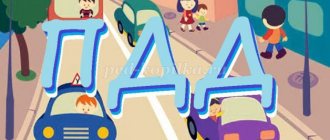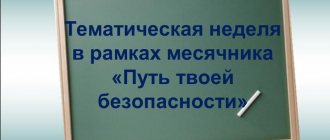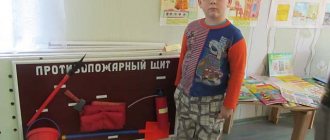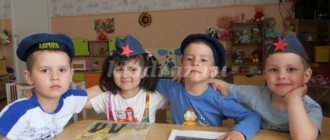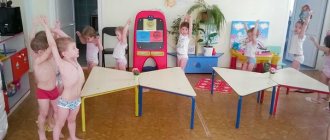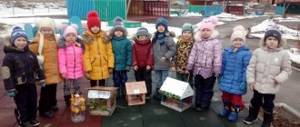Fire safety on the street
A dangerous fire can occur not only at home, but also outside. For example, you may encounter dry grass burning. During training, children are taught how to properly make fires and the need to remove trash, papers, and flammable objects after themselves. The resulting material is consolidated in playful forms and in creativity. You can invite children to draw a picture based on the theme, color pictures, or create applications. Following the results, an exhibition of works will be organized.
Fire behavior in the forest
Children should know the rules of behavior not only in everyday life, but also in nature. Preschoolers can go out into nature in organized groups with teachers. Such a vacation is not always safe, since forest fires are considered one of the most destructive disasters.
Etiquette and rules of behavior for children at the table
When letting children go into the forest with a group, you need to give them safety instructions:
- The child should know that fire from a lit fire can very quickly spread to dry grass. It must be extinguished immediately with sand, water or clothing.
- If you cannot cope with the fire, you need to leave the danger zone as quickly as possible and call the fire department.
When running away from fire, you need to take into account the direction of the wind!
Fireworks are not a toy for children
An unchanging attributes of the New Year holidays - colorful fireworks attract children's attention, but pose a huge danger. Parents need to teach their children from early childhood that pyrotechnics should not be approached without adults. It should only be stored out of the reach of children.
Special control is exercised over the sale of pyrotechnic products. It can be purchased only from 14 years of age, some products are allowed for sale only from 18 years of age.
Important! Parents should only use fireworks strictly in accordance with the manufacturer's instructions.
Fire safety activities with children in preschool educational institutions
The task of parents and educators is to help the child understand the world around him. Adults should take special care to familiarize children with the dangers that may await them.
From an early age, in kindergarten, according to the Federal State Educational Standard, classes on fire safety are provided. Their goal is to develop in children the skills of correct behavior both in everyday life and in the event of a critical situation.
Fire safety action plan in preschool educational institutions
Program development plays a major role in the educational program. Development of a project development plan includes:
- Introducing parents and children to the goals of the program.
- Conducting a survey among parents.
- Involving them in the selection of materials for the production of visual material.
- Organization of joint work on creating posters.
- Selection and reading of fiction on PB.
- Working with didactic games on the topic.
- Creating a presentation.
- Selection of materials for experiments and experiments.
Note! One of the effective methods of the educational process is to conduct an open lesson in secondary and preparatory groups. They can be organized in the form of a theatrical performance.
Rules of behavior on the street for children
At the end of all activities, a generalization and summing up should be carried out. At this stage, the teacher should pay attention to how the children have mastered the material covered.
Forms of conducting fire safety classes in the middle group
In the middle group, the acquired knowledge should be expanded. Children learn that fire can only be a friend if it is handled correctly. At the slightest mistake, this is the most terrible enemy.
The children are introduced to the work of the fire service in more detail. Any material is presented in a playful way.
Open lesson
Forms of conducting fire safety classes in the junior group
Fire safety training should begin with the younger group. During this period, the teacher introduces the children to the concept of “fire”. Knowledge is given about sources of ignition in the apartment. An idea of the firefighter profession is formed.
All classes are conducted exclusively in a playful form, fairy-tale characters should be involved, and toys should be used. All material should be presented in a form that is accessible to children. It is important to use the maximum possible methods of visibility,
Behavior for the little ones: what to do if a fire starts
From an early age, children need to be introduced to the first signs that indicate the start of a fire. The child must understand that if there is a smell or smoke, these signs cannot be ignored.
Important! The child should know someone from reliable neighbors who can turn to for help!
If the source of the fire is at home, you should not try to extinguish it yourself. You need to call 01 and notify adults. Children should clearly know that fires from household electrical appliances cannot be extinguished with water.
Material fastening form
Project on Fire Safety Rules in the senior group in kindergarten
Project activities in the senior preparatory group.
Author: Olga Nikolaevna Kolosova, teacher.
Place of work: MDOU - compensatory kindergarten No. 196 in Saratov Planning project activities on fire safety in the senior preparatory group.
Project “Don't joke with fire!” was started on November 6, 2012 and completed on December 6, 2012. Project type: informational and creative. Type of project: short-term (4 weeks) Subject area: increasing the competence of preschool children in the basics of fire safety. Participants: children of the senior preparatory ophthalmological group “Semitsvetik”, teaching staff of the group, parents of students. Problem: Children do not have a clear understanding of the hidden dangers of fire, games with matches, explosive and flammable objects. Relevance of the project: • Increase in the number of natural disasters, including fires, in recent years; • 60% of fires, according to statistics, occur due to the fault of preschool children; • lack of a protective reaction in children in extreme situations, lack of development of basic self-preservation skills Project goal: To develop in children a conscious and responsible attitude to the implementation of fire safety rules, equipping them with the knowledge, skills and abilities necessary to act in extreme situations involving fire. Project objectives: 1. Developmental Develop: * the ability to realistically assess possible danger; * cognitive activity; * independent work skills * communication skills; * children's creative abilities. *Form the basics of safety in one’s own life. Educational To teach: *skills for safe behavior at home; * rules of dialogue when calling the fire service; *respect for the work of firefighters. Expected results of the project. * Changing children's attitudes towards their safety and health; * mastering the skills of correct actions in case of fire and competent dialogue with the dispatcher of service “01”; *increasing parents' interest in this problem. Project work plan Stage 1 - preparatory. *At a parent meeting held on October 2, 2012, a message was heard about the upcoming development of the project. The topic of fire safety was proposed as an option for consideration, which everyone unanimously approved. *The next step was a diagnostic study of children’s knowledge in the field of fire safety (in the form of an interview). The survey was conducted in the form of individual work in the first and second half of the day. *At the same time, there was a study of the questionnaires offered to the pupils’ parents to fill out. *The survey and questionnaire data obtained confirmed the existence of the problem being discussed in the group. The goals and objectives of the project were set taking into account the diagnostic results. Results of studying the level of children's knowledge on fire safety: 9 children were interviewed; a high level was not identified; three children had a medium level. Low – for six pupils. Stage 2 - project development. *Drawing up an action plan to achieve the goal: who to turn to for help, identifying sources of information, selecting materials and equipment for the work. It was decided to carry out project activities in three directions, involving children, parents and teachers. At this stage, material for classes was selected: posters on a fire safety theme, handouts, games, poems, riddles, works of fiction. It was planned to seek help from G.I. Klyusova (safety engineer) in conducting a tour of the kindergarten in order to become familiar with the fire warning system and fire extinguishing means.
*Project Product Definition The project product was to be an entertainment event and a booklet for parents.
Selected material for organizing classes, individual work, didactic games: 1. Educational posters on a fire safety theme. 2.Handouts and cards for individual work. 3. Board game “I know all professions.” 4. T.A. Shorygina. “Fire safety rules for children 5-8 years old” (lesson notes). 5.T.N.Garnysheva. “Life Safety for Preschoolers” (lesson notes). 6.E.Yu.Ivanova. “100 games, scenarios, holidays.” 7. S. Marshak “Cat House”. 8. S. Marshak “The Story of an Unknown Hero.” 9.S.Marshak. "Fire". 10. A. Gimadeeva. "Don't play with fire." 11.L.bilalov. "Firefighters". 12.T.Fetisova. “Where are the red cars rushing?” Stage 3 - direct educational activities, or implementation of the project. *conducting a series of information content classes. *work with posters and handouts; *familiarity with works of children's literature that touch on the theme of fire; * dramatization of passages from texts; * a tour of the kindergarten to get acquainted with the fire warning system and fire extinguishing means; *work with parents in the form of consultations; *joint activity with parents: preparing drawings. No. Activities carried out (Date, Time of implementation (regime moments). 1. Lesson “Good fire and evil fire.” (educators) November 7, 2012 Group lesson. 2. Lesson “Matches are not a toy, fire is not fun.”( educators) November 8 Group lesson 3. Lesson with elements of the didactic game “What should you do in case of a fire?” (educators) November 12 Afternoon 4. A series of classes on the topic “Fire truck and fire-fighting equipment.” (educators) November 19-26 Group lesson. Individual work in the afternoon and during morning conversations. 5. Reading the poem by S.Ya. Marshak “Fire” and a conversation on its content. (educators) November 15 Group lesson 6. Reading the poem by S.Ya. Marshak “The Story” about an unknown hero. (educators) November 22 Group lesson 7. Reading of S. Marshak’s poem “Fire” (educators) November 16 Afternoon 8. Excursion to introduce the fire safety corner in kindergarten (G.I. Klyusova) November 26 First half of the day 9. Watching the DVD of the cartoon “Cat's House” with subsequent discussion of the content. (educators) November 23 Afternoon 10. A series of classes in a creative workshop on the topic “In case of fire, call 01!” (additional education teacher Litvinova I.N. ) November 20-27 Group lesson according to schedule
11. A series of classes on the topic “Fire safety rules when handling household electrical appliances” (Teacher-speech pathologist Filippova E.V.) November 29-December 4 Subgroup classes according to schedule
12. Introduction to fire safety signs (Filippova E.V.) November 28 Group lesson according to schedule 13. Consultation of parents on the project material. (educators) Throughout the month At morning meetings and in the evening. 14. Dramatization of an excerpt from S. Marshak’s poem “Cat’s House” November 30 -December 5. Afternoon. Application
We recommend watching:
Project in kindergarten for older preschoolers 5-7 years old on legal topics Project in the senior group of kindergarten Project in the senior group on the topic “Trees and shrubs in spring” Project in the senior and preparatory group of the kindergarten
Similar articles:
Project for children of the senior group “Our cheerful garden”
